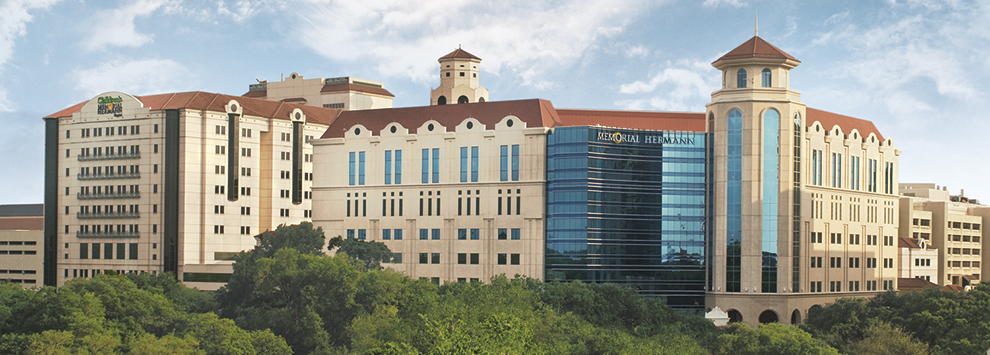Memorial Hermann-Texas Medical Center
Memorial Hermann-Texas Medical Center (MH-TMC) is a private, non-profit, teaching institution established in 1925. It serves as the primary teaching hospital of The University of Texas Medical School at Houston. It was the first institution built on what is now the Texas Medical Center. The hospital, named after George Hermann, who left it as a part of a trust, overlooks Hermann Park.
MH-TMC consists of six pavilions:
- the Hugh Roy and Lillie Cullen Pavilion, constructed in 1925;
- the Robertson Pavilion, finished in 1948;
- the Jones Pavilion, opened in 1977;
- the Hermann Pavilion, opened in 1999.
- the Heart and Vascular Institute, opened in 2008
- and the brand new Sarofim Pavilion, opened in 2020
The six interconnected buildings comprise over a million square feet of space. The Cullen Pavilion, newly renovated and restored to its original grandeur, accommodates medicine beds almost exclusively.
MH-TMC is a Level 1 Trauma Center, equipped to handle any emergency situation. House Staff may accompany some Life Flight missions. MH-TMC offers specialized facilities including:
- the Hermann Burn Center
- The Texas Kidney Institute which provides extensive care for all stages of kidney disease
- The University Magnetic Resonance Imaging Center at Hermann
The Memorial Hermann Heart and Vascular Institute, completed in March 2008, occupies 230,000 square-feet, housing 147 patient beds, including a 20-bed short stay unit, CVICU cardiac care unit, six cardiac catheterization and electrophysiology labs. Laboratories for gastroenterology and pulmonary procedures are also fully equipped and on the leading edge of diagnostic capabilities. A Hyperbaric Medicine Center for treatment of barotrauma and other conditions is on site. The Toxic Fume Inhalation Center for treatment of victims of accidents that occur around toxic or flammable substances has been established as an adjunct to Occupational and Environmental Medicine at Hermann Hospital, which provides a full range of services for industrial clients. The University of Texas/Hermann Hospital Gallstone Treatment Center offers a multi-disciplinary approach to treatment of gallstones including extracorporeal shock wave lithotripsy.
The Susan and Fayez Sarofim Pavilion is the new home of the Red Duke Trauma Institute at Memorial Hermann-Texas Medical Center, and is a testament to Memorial Hermann’s legacy of care and innovation for the community. Built to provide life-saving care for the most critically ill and injured patients, this 17-story tower provides an additional 1.34 million square feet to the existing 2.5 million square-foot campus, allowing for the expansion of trauma, critical care and heart & vascular services—for today and tomorrow. With 186 patient beds all equipped to handle critically ill patients, the pavilion opened mere months before the COVID-19 pandemic was declared, and was instrumental in being able to help handle the volume of critically ill patients, not only in the city of Houston, but in the entire Texas and Gulf Coast region.
MH-TMC also has clinical research facilities. The University Clinical Research Center at Hermann Hospital has been funded in part by the National Institutes of Health. Currently, active protocols include studies of obesity, osteoporosis, hypertension, heart disease, blood clotting problems, Marfan’s Syndrome and infectious diarrhea. At the Center for Cardiovascular and Imaging Research, positron emission tomography (PET) is being used as a diagnostic and research tool for quantitative pictures of the function, metabolism, and blood flow to the heart, brain, and other organs.
There are four general internal medicine services caring for patients of private physicians and full-time faculty. The intensive care unit (ICU) team cares for the 16 bed ICU, with residents covering night call every 4th day. There are a wide variety of subspecialty teams caring for patients that residents rotate through. Float teams at night cover the teams not on call. All divisions have active consultative services with fellows, residents, and students. Patients are admitted to Hermann from private and academic faculty clinics, house staff panel clinics, the emergency center, and upon transfer from outlying areas of Texas, as well as the world.
As well as patient care, residents’ education includes morning/intake reports taking place daily and daily noon conferences. Two chief residents are on site, staffing one to two medicine team and providing teaching and guidance for residents.
Memorial Hermann-Texas Medical Center and the Medical School work closely together, manifested with each floor of the Medical School connecting to the hospital. This provides easy access and readily available support from the academic faculty and convenience for house staff and students who attend conferences. Clinical faculty are based in nearby private offices, many in Hermann Professional Building, just across the street, and connected by a bridge over Fannin Street. Private internists utilize this proximity to supervise care of their patients by medicine house staff while they participate in the academic community and research.
